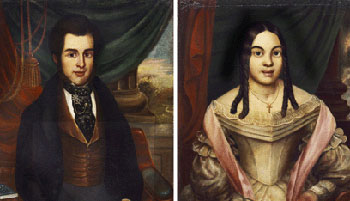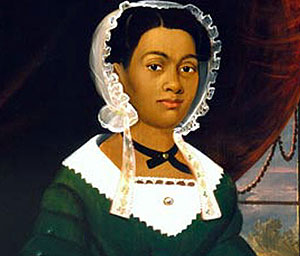I’ve learned that you don’t have to make important finds at auctions. Sometimes, museums themselves can discover treasures among their troves of donated and purchased items.
That was the case recently at the Philadelphia History Museum at the Atwater Kent. A local writer named David Emmi came across two pendant portraits of an African American businessman and abolitionist named Stephen Smith and his wife, Harriet Lee Smith, according to a story in my local newspaper, the Philadelphia Inquirer. The portraits are believed to date to the 1830s, and papers at the museum say that they were painted by an African American.

This was not the first pre-Civil War African American couple portrait to grace Philadelphia in the last year. The Philadelphia Museum of Art mounted an exhibit of a pair of portraits of Hiram Charles Montier and his wife Elizabeth Brown Montier. Hiram Montier was a bootmaker and descendant of the son of Philadelphia’s first mayor. These portraits are believed to be from 1841. They are on loan from the Montier descendants, who said they had been kept for years under their grandmother’s bed. (The portraits above are of Hiram Montier and his wife Elizabeth, from the Antiques and Arts Online website.)
Portraits were the most popular type of painting up into the 19th century, according to the National Gallery of Art website. Sitters had themselves painted – the work was usually done by roaming nonskilled artisans – among nice interiors or landscapes to project their social status, the website said. As writer Emmi noted, a portrait of a black man before the Civil War was rare.
In 2006, the Delaware Art Museum exhibited 70 paintings, photographs, silhouettes and prints of African Americans from the 1700s to 1890s. Blacks used the portrait sittings, according to the exhibit, to “express common middle-class ideals and social aspirations.” (The painting below is of Mrs. Nancy Lawson (1843), from the collection of the Shelburne Museum, VT. It was part of the exhibit.)

The portraits from the Atwater collection were discovered in storage, and had been donated in 1931 to the Historical Society of Pennsylvania by Henrietta Clemens Mouserone, Smith’s grandniece, according to the newspaper. The Atwater Kent got them 20 years ago from the society. Smith was born in slavery in 1797, bought his freedom at 20 and became a wealthy businessman in Lancaster County, PA, according to the newspaper. He eventually moved to Philadelphia, built a lumber and coal business and continued his involvement in the Underground Railroad.
The Montiers were part of one of the largest free black communities in the North, according to Antiques and Arts Online website. Hiram Montier was descended from Richard Morrey, son of Philadelphia Mayor Humphrey Morrey, and Cremona Morrey, a black woman with whom he lived in Cheltenham during the 18th century.
Although not portraits, in my research I found that scholar W.E.B. DuBois presented a collection of photographs of black life 35 years after slavery during the 1900 Paris Exposition. He chose about 500 photos of blacks in successful roles, rather than the stereotypical negative ones. NPR in 2003 conducted an interview with historian Deborah Willis who wrote a book based on DuBois’ presentation, “A Small Nation of People.” Here’s a look at some of the images.
These are the types of discoveries that keep me searching in auction bins and at auction houses for hidden treasures.
Update: My local newspaper, the Philadelphia Inquirer, ran a story on June 23,2011, about a man who was related to the Montiers. He had presented their portraits to the Philadelphia Museum of Art two years earlier and had been searching for their graves. With a little help, he found them at Eden Cemetery in Collingdale, PA.
